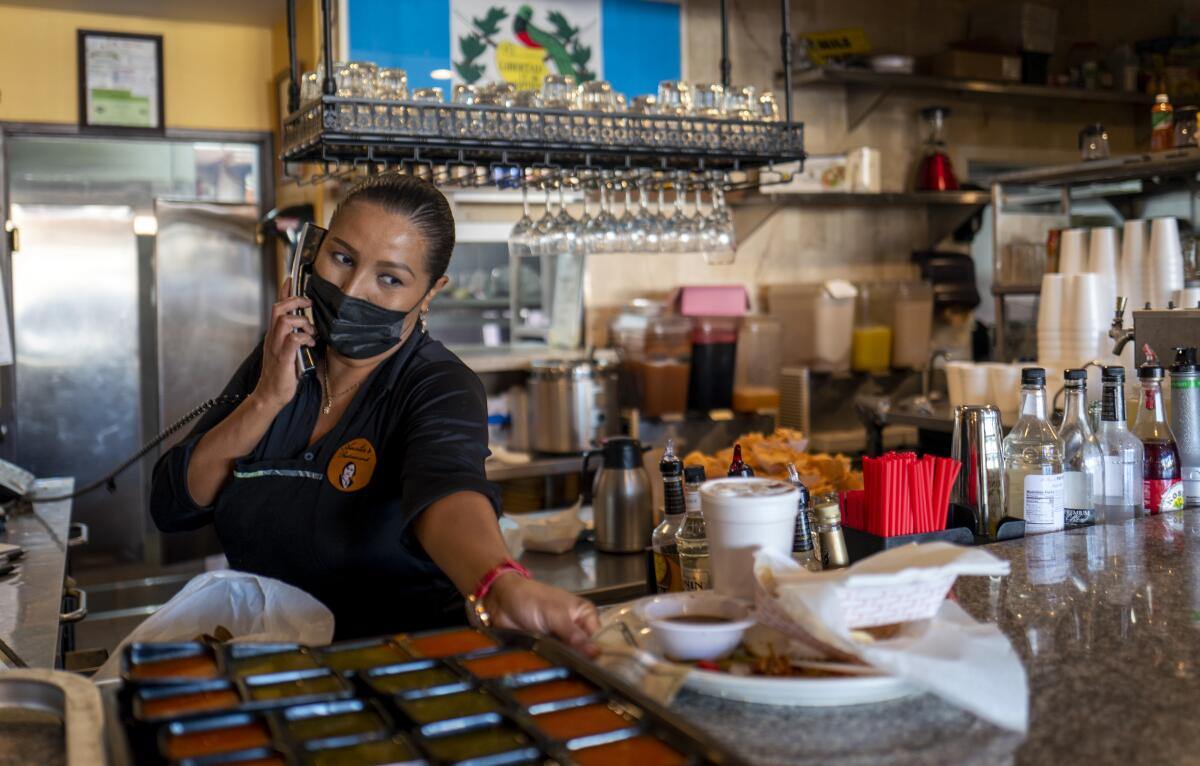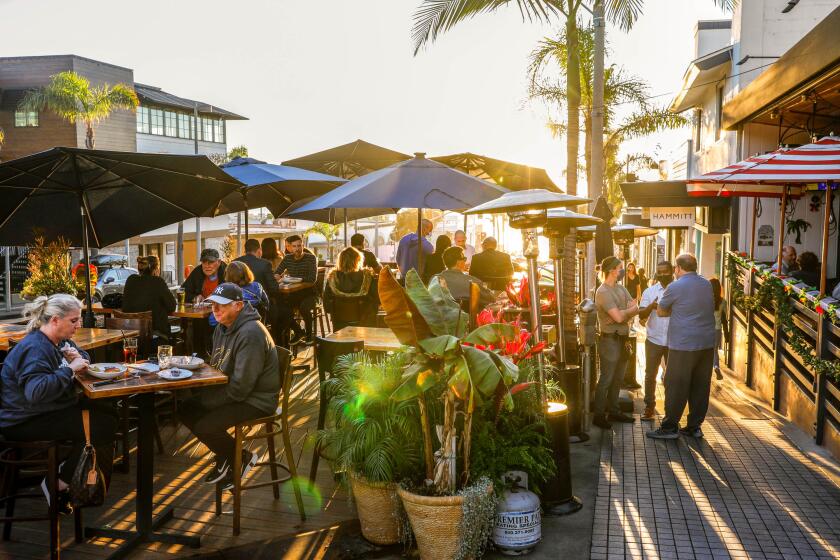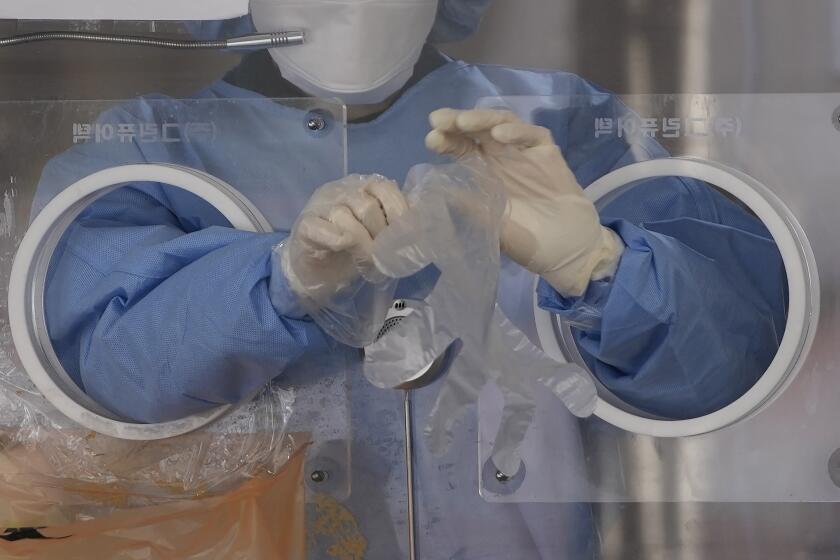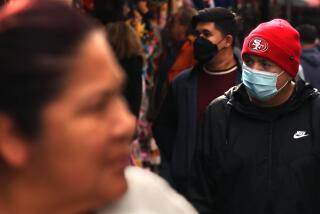Why California isn’t planning new lockdowns or restrictions for the Omicron variant

- Share via
When the new Omicron variant became known last week, there was anxiety about whether it would lead governments to consider new restrictions just as the holidays arrived.
And while the variant has now been detected in California, officials say that they don’t think they’ll need to implement significant new restrictions, saying travel plans can be pursued and policies already in place around masks and vaccine verification are the best path for combatting the new strain of the coronavirus.
“This has been an extraordinarily long and challenging time, and people are right to feel fatigued,” Los Angeles County Public Health Director Barbara Ferrer said. “I think the best way to put all of this in perspective is we actually have a lot more powerful tools at our hand right now than we did last year.”
No significant new coronavirus-related restrictions are planned in Los Angeles County despite the emergence of the Omicron variant.
Why this approach?
Officials are quick to note that the state of the pandemic is much different this year, given the ample supply and availability of vaccines, which are expected to provide at least some degree of protection against Omicron, particularly against severe illness and death.
Also on the horizon is the likely authorization of pills that can reduce the risk of severe disease.
The basic strategy remains getting more unvaccinated people — including young children — their shots and encouraging eligible vaccinated adults to get boosters.
“Boosters are absolutely essential, particularly for people who got vaccinated a while ago,” Ferrer said.
Bay Area health officials echoed those beliefs.
“There’s lots of questions regarding how transmissible is it, how easy does it spread. … However, here’s what’s important to know: We have so many tools now that we’ve not had in other parts of the pandemic. And we know how to use them,” Dr. Sara Cody, the Santa Clara County health officer and director of public health, told KTVU-TV.
“I actually think that we are in a far better place facing this new unknown than at any other time in the pandemic,” Cody said.
In a briefing Wednesday after the first case of the Omicron variant was reported in California, Gov. Gavin Newsom said there was no reason to assume that future lockdowns were in store for the state.
“I see no indication at this moment whatsoever that that’s in our immediate future as long as we continue our nation-leading efforts,” the governor said, noting that residents’ decisions will “determine our fate and future.”
In a joint statement, the California and San Francisco Departments of Public Health said vigilance against the variant is necessary, but its arrival in the state is “not a cause for panic.”
“We recognize that everyone is exhausted, and the news of a new variant can be overwhelming,” the statement said. “It is important that we collectively focus on the things we know prevent the spread of COVID-19 and its variants. Individuals should get vaccinated and boosted; wear your mask in indoor settings; get tested if you have symptoms; and stay home if you are sick.”
Omicron’s impact on the COVID-19 pandemic will depend on a variety of factors that will take days to weeks for scientists to untangle.
Vaccinations are key weapon
Health officials have long stressed the importance of taking a layered approach to combating the coronavirus. While wearing masks in public, avoiding indoor crowded settings and, especially, getting vaccinated all afford some degree of protection, those tools work best when used together.
“We need people to be sensible and cautious, and we’re going to pay a lot of attention to the science,” Ferrer said. “Obviously, if there’s emerging information that requires us to rethink the safety messaging, we’ll be coming back both to the board and to the public.”
Demand is so high for booster shots in Marin County that some residents are reporting difficulty getting an appointment this week from local pharmacies. KGO-TV reported that one pharmacy in Marin County ran out of vaccine on Friday, forcing appointments to be canceled through Sunday.
“This is a logistical issue. The demand has increased so quickly that not all of our pharmacies have been able to keep up with that demand, in terms of just getting supplies through the regional distribution networks,” Dr. Matt Willis, Marin County’s health officer, told KGO-TV. The TV station quoted Walgreens and CVS as saying they were working on replenishing stores with more shots.
Officials hope demand for the vaccine — and booster shots — grows across the state this week amid the new Omicron threat.
Nearly 64% of Californians are fully vaccinated, according to The Times’ vaccine tracker, but that figure is too low to curb an expected fifth surge of COVID-19 this winter. There has been an uptick in demand for shots among 5- to 11-year-olds, and interest in booster shots is rising, but authorities are concerned about lackluster rates of vaccination among young adults.
Early demand for the COVID-19 vaccine for young children has been startlingly uneven in California, with some areas embracing the shots and others much slower to accept them, a Times data analysis last week found.
Meanwhile, the percentage of vaccinated Los Angeles County residents who have gotten COVID-19 booster shots is significantly lower in poorer neighborhoods than other areas.
More to Read
Sign up for Essential California
The most important California stories and recommendations in your inbox every morning.
You may occasionally receive promotional content from the Los Angeles Times.














